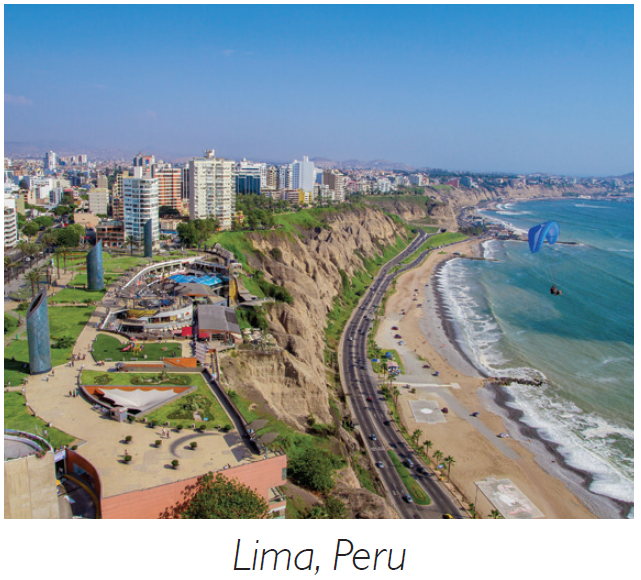Borrower Overview
TriLinc has provided financing to a clean diesel distributor in Lima, Peru, that is engaged in fuel reception, storage, and distribution. Founded in 2006, the borrower owns a state-of-the-art import terminal, located in Puerto Callao, with offshore fuel offloading, onshore fuel blending capabilities, and approximately one million barrels of storage capacity. The borrower mainly distributes ultra-low sulfur diesel, jet fuels, and gasohols to wholesalers, gas stations, and transportation companies throughout the country. The borrower conducts proprietary sampling and environmental monitoring in compliance with Peruvian regulations, in addition to undergoing external inspections by its suppliers and offtakers, including Latam Airlines, part of Latin America’s largest airline holding company. In an effort to improve emissions and air quality, in 2012 the Peruvian Ministry of Transport and Communications implemented a law banning the sale of diesel with sulfur levels above 50 ppm in several of the major metropolitan areas of Peru. This ultra-low sulfur diesel requirement cannot be met internally, so Peru remains a net importer of both crude and refined products. TriLinc’s financing will provide the borrower with a source of liquidity to purchase inventory and meet the demand stemming from new contracts, allowing the borrower to grow its employee base in line with its revenue and growth projections. These contracts will aid in increasing the availability of ultra-low sulfur fuel in Peru, subsequently enhancing access to clean energy for local consumers.
Market Overview

Peru is classified as an upper middle-income country by the World Bank.1 Between 2010 and 2016, GDP growth rates averaged approximately 2.2%.1 Peru’s main exports are concentrated in metals, petroleum and natural gas, agricultural goods, and textiles.1 Conversely, the country’s main imports are focused in petroleum and petroleum products, chemicals, plastics, machinery, vehicles, and television sets, among others.2
Peru meets TriLinc’s country standards for its performance across relevant growth, stability and access metrics3. In 2016, it ranked 3rd across the Latin American region on the World Bank’s Ease of Doing Business Index.4. Corruption and inefficient government bureaucracy are seen as the two most pressing hurdles currently facing the country’s global competitiveness5. As the sixth largest economy in Latin America and the Caribbean with a GDP of $192.1 billion6, the country benefited from the estimated $268.1 billion in foreign direct investment that flowed into the region in 20167. Although the region experienced a 2016 GDP growth rate of -1.4%, the 2019 GDP growth rate is projected to increase to 2.5%.8
Additional Sustainability Sustainability & Highlights
- The borrower conducts proprietary environmental monitoring on air quality, noise, emissions, and sea water quality in accordance with Peruvian Technical Standards and the Ministry of Environment.
- Employees participate in annual training programs focused on port safety, emergency response planning, and hazardous material management. Additionally, the company offers daily lessons on topics such as occupational health precautions and environmental management practices.
- The borrower conducts proprietary environmental monitoring on air quality, noise, emissions, and sea water quality in accordance with Peruvian Technical Standards and the Ministry of Environment.

1The World Bank, World Development Indicators Database, Peru, 2016. 2CIA, The World Factbook, 2016: Peru. 3There is no assurance that our investment in this company or this market will be successful. 4World Bank, Doing Business 2016 Measuring Regulatory Quality and Efficiency. 5World Economic Forum, Global Competitiveness, 2017. 6The World Bank, World Development Indicators Database, 2016. 7The World Bank, Data, Latin America & Caribbean, 2016. 8The World Bank, Global Economic Prospects, June 2017.
The above information is as of the initial date of investment: August 2, 2016.
This borrower is no longer a TriLinc fund investment.
TriLinc originally performed an SDG mapping exercise in December 2017 to map all of our borrower companies, both current and exited from our portfolios, to specific SDGs based off of business activity. TriLinc’s official SDG alignment methodology was not finalized until June 30, 2018. For borrowers that had exited TriLinc’s portfolios prior to this time period, the selected SDGs for these borrower are a reflection of what TriLinc believes would have been the SDG alignment if 1) the SDGs had been in effect and 2) TriLinc had integrated the SDG alignment while the company was in the portfolio. The SDG mapping presented does not include input from Investment Partners or borrower companies given that the companies were no longer in the portfolio when the alignment was finalized.
An investment with TriLinc carries significant fees and charges that will have an impact on investment returns. Information regarding the terms of the investment is available by contacting TriLinc. This is a speculative security and, as such, involves a high degree of risk. Investments are not bank guaranteed, not FDIC insured and may lose value or total value. Some investments may have been made in an investment vehicle that is no longer open for investment. The highlighted investment may or may not have been profitable. There is no guarantee that future investments will be similar.
Want to learn more? Contact Us.
